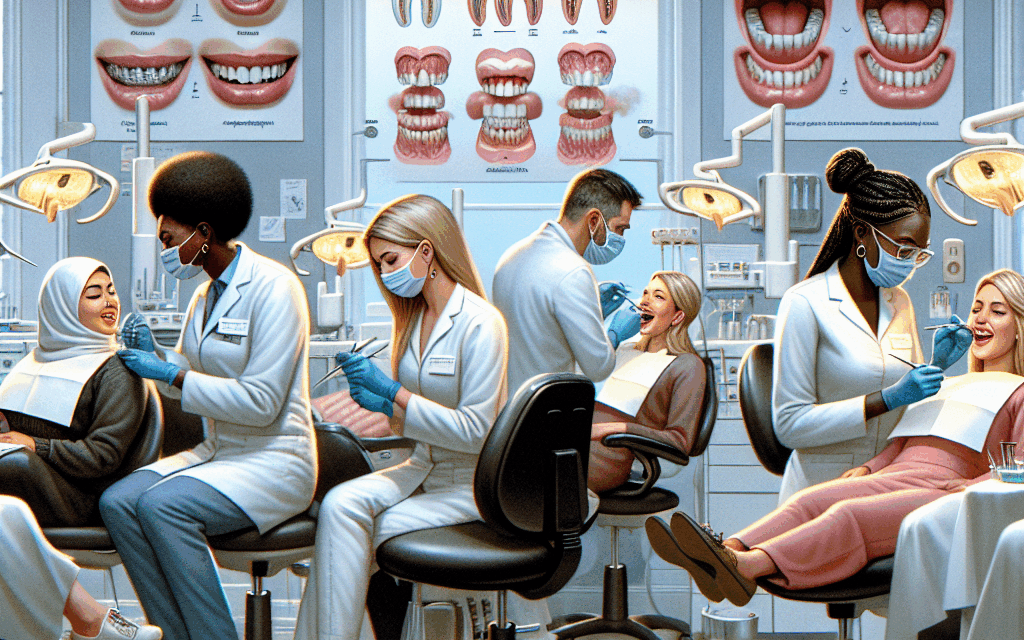UK Dentists Embrace Aesthetic Treatment Expansion
The landscape of dentistry in the United Kingdom is undergoing a significant transformation as practitioners increasingly embrace aesthetic treatments. This shift is not merely a trend; it reflects changing patient expectations, advancements in technology, and a growing recognition of the importance of aesthetics in oral health. This article delves into the various facets of this expansion, exploring the motivations behind it, the types of treatments being offered, the regulatory landscape, the impact on patient care, and future trends in aesthetic dentistry.
Understanding the Shift Towards Aesthetic Dentistry
The rise of aesthetic dentistry in the UK can be attributed to several factors, including societal changes, increased awareness of dental health, and the influence of social media. Patients are no longer just seeking functional dental care; they are also looking for treatments that enhance their appearance and boost their confidence.
Changing Patient Expectations
In recent years, there has been a notable shift in patient expectations regarding dental care. Patients are increasingly aware of the aesthetic aspects of their smiles and are seeking treatments that not only address dental health but also enhance their appearance. This change is driven by several factors:
- Social Media Influence: Platforms like Instagram and TikTok have popularized the concept of the “perfect smile,” leading many individuals to seek cosmetic dental treatments to achieve similar results.
- Celebrity Culture: The influence of celebrities and public figures who openly discuss their dental enhancements has normalized aesthetic treatments, making them more desirable among the general public.
- Increased Access to Information: The internet has made it easier for patients to research dental options, leading to more informed decisions about their care.
As a result, dentists are adapting their practices to meet these evolving expectations, offering a wider range of aesthetic treatments to cater to their patients’ desires.
Advancements in Dental Technology
Technological advancements have played a crucial role in the expansion of aesthetic dentistry. Innovations in materials, techniques, and equipment have made it easier for dentists to provide high-quality aesthetic treatments. Some notable advancements include:
- 3D Printing: This technology allows for the creation of custom dental appliances, such as aligners and crowns, with precision and speed.
- Digital Smile Design: Dentists can now use software to create a visual representation of a patient’s potential smile, helping them make informed decisions about their treatment options.
- Minimally Invasive Techniques: Advances in techniques such as laser dentistry have made it possible to perform aesthetic procedures with less discomfort and faster recovery times.
These technological advancements not only enhance the quality of care but also improve patient satisfaction, further driving the demand for aesthetic treatments.
Popular Aesthetic Treatments Offered by UK Dentists
As the demand for aesthetic dentistry grows, UK dentists are expanding their offerings to include a variety of treatments designed to enhance the appearance of smiles. Some of the most popular aesthetic treatments include:
Teeth Whitening
Teeth whitening is one of the most sought-after aesthetic treatments in the UK. Many patients desire a brighter smile, and whitening procedures can effectively remove stains and discoloration caused by factors such as diet, smoking, and aging. Dentists offer several whitening options:
- In-Office Whitening: This procedure involves the application of a high-concentration whitening gel, activated by a special light, to achieve immediate results.
- At-Home Whitening Kits: Dentists provide custom-fitted trays and lower-concentration whitening gels for patients to use at home, allowing for gradual whitening over time.
- Whitening Toothpastes and Products: Many patients opt for over-the-counter products, but professional treatments are generally more effective and safer.
Statistics show that teeth whitening is one of the most requested cosmetic procedures, with a significant percentage of patients reporting increased confidence after treatment.
Veneers
Dental veneers are thin shells of porcelain or composite resin that are bonded to the front surface of teeth to improve their appearance. They are an excellent option for patients with:
- Discolored teeth that cannot be whitened.
- Chipped or worn teeth.
- Irregularly shaped teeth or gaps between teeth.
The process of getting veneers typically involves two visits to the dentist: one for consultation and preparation, and another for placement. The results are often dramatic, leading to a significant boost in patient confidence.
Orthodontics and Clear Aligners
Orthodontic treatments have evolved significantly, with clear aligners becoming a popular alternative to traditional metal braces. Brands like Invisalign have revolutionized the way patients approach orthodontics:
- Discreet Appearance: Clear aligners are virtually invisible, making them an attractive option for adults and teens who wish to straighten their teeth without the aesthetic concerns of metal braces.
- Comfort: Aligners are made from smooth plastic, reducing discomfort associated with traditional braces.
- Removability: Patients can remove aligners for eating and oral hygiene, making it easier to maintain good dental health during treatment.
As a result, many dentists are incorporating clear aligner therapy into their practices, catering to the growing demand for discreet orthodontic solutions.
Facial Aesthetics
In addition to traditional dental treatments, many UK dentists are expanding their services to include facial aesthetics. This includes treatments such as:
- Botulinum Toxin (Botox): Used to reduce the appearance of fine lines and wrinkles, Botox is increasingly offered by dentists who have undergone specialized training.
- Dermal Fillers: These are used to restore volume and enhance facial contours, complementing dental aesthetics.
- Gummy Smile Treatments: Dentists can perform procedures to reduce the appearance of a gummy smile, enhancing overall facial aesthetics.
The integration of facial aesthetics into dental practices allows dentists to provide comprehensive care that addresses both dental and facial concerns, appealing to a broader patient base.
Cosmetic Bonding
Cosmetic bonding is a versatile treatment that involves applying a tooth-colored resin to repair or enhance the appearance of teeth. It is often used for:
- Chipped or cracked teeth.
- Discolored teeth that do not respond to whitening.
- Gaps between teeth.
The procedure is relatively quick and can often be completed in a single visit, making it an attractive option for patients seeking immediate results. The resin can be shaped and polished to match the natural teeth, providing a seamless appearance.
The Regulatory Landscape of Aesthetic Dentistry in the UK
As the demand for aesthetic treatments grows, so does the need for regulation to ensure patient safety and quality of care. The regulatory landscape for aesthetic dentistry in the UK is complex and evolving.
Current Regulations and Guidelines
The General Dental Council (GDC) is the regulatory body for dental professionals in the UK, overseeing the practice of dentistry and ensuring that practitioners adhere to high standards. Key regulations include:
- Registration: All dentists must be registered with the GDC to practice legally in the UK.
- Continuing Professional Development (CPD): Dentists are required to engage in ongoing education to stay current with advancements in dental care, including aesthetic treatments.
- Informed Consent: Dentists must obtain informed consent from patients before performing any aesthetic procedures, ensuring that patients understand the risks and benefits.
These regulations are designed to protect patients and ensure that they receive safe and effective care. However, the rise of non-dental practitioners offering aesthetic treatments has raised concerns about the need for stricter regulations.
The Role of Non-Dental Practitioners
The increasing popularity of aesthetic treatments has led to a rise in non-dental practitioners, such as beauticians and nurses, offering services like Botox and dermal fillers. This trend has sparked debate about the need for regulation in this area:
- Safety Concerns: There are concerns about the safety and efficacy of treatments performed by non-dental professionals, as they may lack the necessary training and expertise.
- Quality of Care: Patients may not receive the same level of care and follow-up as they would with a qualified dentist.
- Regulatory Gaps: The current regulatory framework does not adequately address the practices of non-dental practitioners, leading to calls for reform.
As the aesthetic market continues to grow, there is a pressing need for clearer regulations to ensure patient safety and quality of care across all practitioners.
The Impact of Aesthetic Treatments on Patient Care
The expansion of aesthetic treatments in dentistry has significant implications for patient care. While these treatments can enhance appearance and boost confidence, they also raise important considerations regarding patient health and well-being.
Psychological Benefits
Numerous studies have shown that aesthetic dental treatments can have profound psychological benefits for patients. Some of these benefits include:
- Increased Confidence: Many patients report feeling more confident and self-assured after undergoing aesthetic treatments, which can positively impact their personal and professional lives.
- Improved Quality of Life: Aesthetic improvements can lead to greater satisfaction with one’s appearance, contributing to an overall improved quality of life.
- Social Acceptance: In a society that often places a high value on appearance, aesthetic treatments can help individuals feel more accepted and integrated into social circles.
These psychological benefits underscore the importance of considering the emotional aspects of dental care, particularly in aesthetic dentistry.
Ethical Considerations
The rise of aesthetic dentistry also raises ethical considerations for practitioners. Dentists must navigate the fine line between meeting patient desires and ensuring that treatments are appropriate and necessary. Key ethical considerations include:
- Informed Consent: Dentists must ensure that patients fully understand the risks and benefits of aesthetic treatments before proceeding.
- Realistic Expectations: Practitioners should manage patient expectations and avoid promising results that may not be achievable.
- Patient Well-Being: Dentists must prioritize the health and well-being of their patients, ensuring that aesthetic treatments do not compromise their overall dental health.
By addressing these ethical considerations, dentists can provide care that is not only aesthetically pleasing but also responsible and patient-centered.
Future Trends in Aesthetic Dentistry
The future of aesthetic dentistry in the UK looks promising, with several trends expected to shape the industry in the coming years. As technology continues to advance and patient expectations evolve, dentists will need to adapt to stay competitive.
Integration of Technology
As technology continues to advance, its integration into aesthetic dentistry will become increasingly important. Some anticipated trends include:
- Artificial Intelligence: AI can assist in treatment planning and patient management, improving efficiency and outcomes.
- Tele-dentistry: Virtual consultations will become more common, allowing patients to receive advice and treatment recommendations from the comfort of their homes.
- Augmented Reality: AR technology may be used to help patients visualize potential outcomes before undergoing treatments.
These technological advancements will not only enhance the patient experience but also improve the quality of care provided by dentists.
Personalization of Treatments
As patients become more discerning about their aesthetic choices, the demand for personalized treatments will grow. Dentists will need to focus on:
- Customized Treatment Plans: Tailoring treatments to individual patient needs and preferences will become essential for achieving optimal results.
- Holistic Approaches: Integrating aesthetic treatments with overall health and wellness will appeal to patients seeking comprehensive care.
- Patient-Centered Care: Fostering strong relationships with patients and understanding their unique goals will be crucial for success in aesthetic dentistry.
By embracing personalization, dentists can enhance patient satisfaction and loyalty.
Expansion of Services
As the demand for aesthetic treatments continues to rise, many dentists will expand their service offerings to include a wider range of procedures. This may involve:
- Training and Certification: Dentists will seek additional training in aesthetic procedures to broaden their skill sets and meet patient demand.
- Collaboration with Other Professionals: Dentists may collaborate with dermatologists and plastic surgeons to provide comprehensive aesthetic care.
- Increased Marketing Efforts: Practices will need to invest in marketing strategies to promote their aesthetic services and attract new patients.
This expansion will not only benefit patients but also contribute to the growth and sustainability of dental practices.
Conclusion
The expansion of aesthetic treatments in UK dentistry represents a significant shift in the way dental care is perceived and delivered. As patient expectations evolve and technology advances, dentists are embracing a broader range of aesthetic services to meet the demands of their patients. This trend is not without its challenges, including regulatory concerns and ethical considerations, but the potential benefits for patient care are substantial.
As we look to the future, it is clear that aesthetic dentistry will continue to play a vital role in enhancing patient confidence and well-being. By staying informed about industry trends, embracing technological advancements, and prioritizing patient-centered care, UK dentists can navigate this evolving landscape successfully. Ultimately, the integration of aesthetic treatments into dental practices not only enhances smiles but also contributes to a more holistic approach to health and wellness.





